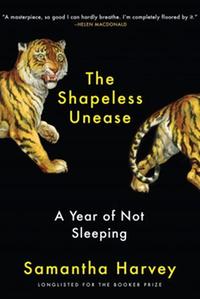
 Sleep won't be much of an option when pondering the questions and images novelist Samantha Harvey raises in her profound, earthshaking memoir The Shapeless Unease: A Year of Not Sleeping.
Sleep won't be much of an option when pondering the questions and images novelist Samantha Harvey raises in her profound, earthshaking memoir The Shapeless Unease: A Year of Not Sleeping.
Harvey (The Western Wind) has been compared by the Telegraph with Virginia Woolf. The comparison holds up. She is a writer of both sparkling effusions and dark, twisted inquiry. The Shapeless Unease defies linear genre and offers a varied look at the somber affliction of insomnia. In 2016, Harvey couldn't sleep. She talked to her doctor, tried various remedies, but all to no avail. She captures her experience of that year in stream-of-consciousness interior monologues--reminiscent of Woolf--and more essay-like probing into the heart of her distress. She's a shapeshifter, in that the point-of-view changes constantly. She writes in first-person then shifts to third-person. Some of her passages are short stories she wrote during that time. Some are dialogues with people trying to help. What's constant is the restless energy propelling the prose: fervent, searching, luminous at times.
The first few sections are a sobering meditation on death. It is a subject that preoccupies the author throughout the sleepless nights. Her cousin died, and she can't reconcile the times they spent together as children with the image of the corpse rotting in the ground. In unflinching detail, she takes us through the stages of decomposition and how humans disappear from the surface of the earth. "It was only ever your vehemence to survive that prevented all that," she writes, describing how bacteria always present in the body finally consume the body upon death.
And from this eternal crisis spring a thousand worries. She is writing during Brexit, and this political crisis keeps her up. She wonders about the future of humanity. She dissects science and religion, and wishes she could be an ardent believer in either. She curses the uncertainty and panic that run beneath her thoughts. She analyzes her interactions with her doctor, the power relation between patient and doctor that often puts the patient at a disadvantage, especially when suffering from something that can be dismissed as neuroses.
The best part of The Shapeless Unease, though, is the author's exploration of writing. The act of writing saves her in the night, and she delves into what constitutes the miraculous phenomenon known as the written word. "Writing is dreaming," she explains. "It is lucid dreaming--the work of the subconscious that has a toe in the conscious, just enough to harness the dream's waywardness." Writing uncovers the ineffable, she insists. And as if to prove her point, the book offers one incredible metaphor after another, limning the sublime. "The self can find a way out," she concludes, "which I think is what love is--the escape of the self from the self."
This memoir churns deep in the soul. Here is a talented writer plumbing her personal experience as deeply as she can. The results are staggeringly beautiful. The Shapeless Unease belongs on the nightstand of every literary-minded insomniac. --Scott Neuffer, writer, poet, editor of trampset
Shelf Talker: Novelist Samantha Harvey grapples with her insomnia and life's biggest questions in this brilliant, genre-bending memoir.

